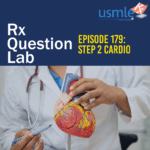Shock

Looking for more information on this topic? Check out the Shock brick. If you enjoyed this episode, we’d love for you to leave a review on Apple Podcasts. It helps with our visibility, and the more med students (or future med students) listen to the podcast, the more we can provide to the future physicians of…
Read MoreRx Question Lab: USMLE Step 2 CK Cardiology

Tackle High-Yield Concepts for USMLE Step 2 CK Cardiology This interactive session, led by Dr. Abraham Titus (Hematology/Oncology Fellow, University of South Alabama) and ScholarRx’s Jeff Downing, focuses on challenging USMLE Step 2 CK cardiology questions that will sharpen your clinical decision-making skills and deepen your understanding of cardiovascular medicine. WHAT YOU’LL LEARN: In this…
Read MorePhysiology of the Renal Tubular System

Looking for more information on this topic? Check out the Physiology of the Renal Tubular System brick. If you enjoyed this episode, we’d love for you to leave a review on Apple Podcasts. It helps with our visibility, and the more med students (or future med students) listen to the podcast, the more we can provide…
Read MorePericardial Effusion and Cardiac Tamponade

Looking for more information on this topic? Check out the Congenital Adrenal Hyperplasia brick. If you enjoyed this episode, we’d love for you to leave a review on Apple Podcasts. It helps with our visibility, and the more med students (or future med students) listen to the podcast, the more we can provide to the future…
Read MoreBlood Pressure Control: Foundations and Frameworks (Re-release)

Looking for more information on this topic? Check out the Thrombotic Disorders: Foundations and Frameworks brick. If you enjoyed this episode, we’d love for you to leave a review on Apple Podcasts. It helps with our visibility, and the more med students (or future med students) listen to the podcast, the more we can provide to the…
Read MoreDiuretics: Foundations and Frameworks (Re-release)

Looking for more information on this topic? Check out the Physiology of Diuretics brick. If you enjoyed this episode, we’d love for you to leave a review on Apple Podcasts. It helps with our visibility, and the more med students (or future med students) listen to the podcast, the more we can provide to the future…
Read MoreRx Question Lab – Neurology

Join us for this special edition of the Rx Bricks Podcast, featuring a complete Rx Question Lab session designed to help medical students master high-yield neurological concepts for USMLE Step 1. In this interactive session, we work through four challenging board-style questions that cover essential neurology topics, including speech disorders, genetic syndromes affecting the nervous…
Read MoreHypertensive Emergency

Looking for more information on this topic? Check out the Emergent Hypertension brick. If you enjoyed this episode, we’d love for you to leave a review on Apple Podcasts. It helps with our visibility, and the more med students (or future med students) listen to the podcast, the more we can provide to the future physicians of…
Read MoreGlycogen Storage Diseases

Glucose is the main source of energy for all forms of life, but it isn’t usually stored as individual C6H12O6 molecules. Animals use glycogen to do that job. Glycogen is a large branched polymer of glucose molecules, linked together by α-1,4 and α-1,6 glycosidic bonds. The liver and muscles break down the stored glycogen whenever the…
Read MoreAcid-Base Disorders: Putting It All Together (Re-Release)

Looking for more information on this topic? Check out the Acid-Base Disorders: Putting it all Together brick. If you enjoyed this episode, we’d love for you to leave a review on Apple Podcasts. It helps with our visibility, and the more med students (or future med students) listen to the podcast, the more we can provide…
Read More

